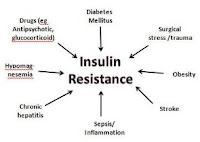Understanding Insulin resistance is a condition in which normal amounts of insulin are inadequate to produce a normal insulin response from fat, muscle and liver cells. Insulin resistance in fat cells reduces the effects of insulin and result in increased hydrolysis of triglycerides stored in the absence of measures which either increase insulin sensitivity or which provide additional insulin.
Increased mobilization of stored lipids in these cells elevates free fatty acids in the blood plasma. Insulin resistance in muscle cells reduces glucose-making (and so local storage of glucose as glycogen), whereas the cells of insulin resistance in the liver resulting in impaired glycogen synthesis and failure to suppress glucose production.
High blood fatty acid concentrations (associated with insulin resistance and diabetes mellitus type 2), reduces muscle glucose uptake, and increased liver glucose production all contribute to high blood glucose concentrations. High plasma levels of insulin and glucose due to insulin resistance is believed to be the origin of metabolic syndrome and type 2 diabetes, including complications.
Some related conditions including
• Normal way of life, whether the result of the effects of aging on the body or lack of physical exercise (both of which can also result in obesity)
• Haemochromatosis
• Gastroparesis
• Smoking Tobacco
• Coffee (Canadian study has found that consumption of caffeine makes insulin more resistant to changes in blood sugar in patients with and without diabetes.)
• Polycystic ovarian syndrome (PCOS)
• hypercortisolism (eg, steroid use or Cushing's disease)
• Drugs (eg, rifampicin, isoniazid, olanzapine, risperidone, progestogens, corticosterone, glucocorticoids, many antiretrovirals, maybe alcohol, methadone)
• Genetic Causes
• Insulin receptor mutation (Donohue syndrome)
• LMNA mutation (family Partial Lipodystrophy)
Causes Insulin resistance can also be caused by damage to the liver cells after a defective insulin receptors on hepatocytes.

No comments:
Post a Comment